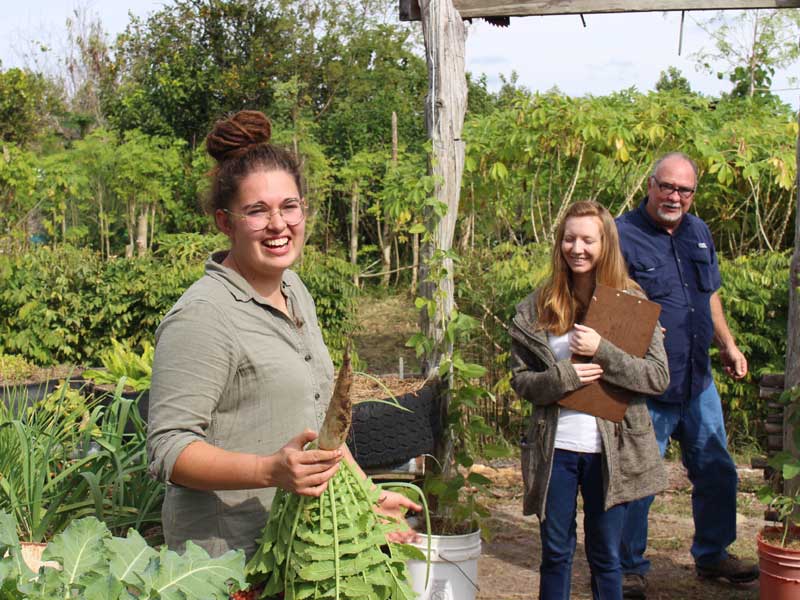by TIM CRAIG
For over 30 years, sustainability has been an integral part of the H.E.A.R.T. Village, a small nonprofit tucked about a mile from the nearest paved road behind Warner University in Lake Wales.
H.E.A.R.T., an acronym for “Hunger Education and Resource Training,” was established in the early 1980s, an outgrowth from two professors from Warner University (then Warner Southern College): Dr. Robert Clark, a former missionary in Bangladesh, and Charlie Smith, a former Peace Corps worker in Malaysia. Together with Dean Flora with Food for the Hungry International, they promoted the idea of creating a college-level, practical training center for Christian workers going to developing regions of the world.
Phil Murphy, H.E.A.R.T.’s executive director since 2010, was there at the beginning. He was a Warner student in 1980, and then volunteered to stay in Lake Wales to help build the village. In 1984, he was a member of the village’s first class. In 1986, after graduating, he and his wife Lonnie served as missionaries in Haiti. For 21 years, the couple founded the House of Blessings Home for Children in Haiti and worked with organizations such as U.S. AID, Samaritan’s Purse, World Vision, M.E.D.A. and Church of God Global Missions in other community development projects.
Yet he did it all with a goal in mind: create something that can go on after you’ve left; make it sustainable.
“It’s unsustainable for Americans to keep sending stuff to different countries,” says Murphy. “It’s more sustainable to take what we teach and implement those ideas and then back away when people are generating on their own. Charlie Smith always taught that in this work, you should work yourself out of a job.”
By 2007, he and his wife were back in Florida, beginning to look for their next adventure. Murphy was approached by then-director Dr. Joe Mattox, who asked if he would come on as Associate Director for two years, then become the director. After some prayer and consultation, he accepted the offer.
When he became executive director in 2010, he knew things needed to change. H.E.A.R.T., which had taught Murphy to build things for sustainability, needed to become more sustainable.
“When I became director, the saying was that H.E.A.R.T. was the best-kept secret in Polk County — even people in Lake Wales didn’t know who we were,” says Murphy. “We have been involved in projects around the world, but now we needed to be more involved locally.”
Using the Village as a “living lab,” Murphy began to further the same kind of sustainability practices they talked about in the classroom into the real world.
“We have the ability to expose people to different ideas and different ways of doing things,” he says, “and we have the ability to not just talk about it, or not just practice it for practice’s sake, but to live in that way.”
They made a decision not to use fertilizers in their gardens, a move toward what he calls “natural farming,” which focuses on feeding the soil as much as growing the plants.
“I’ve learned that the soil itself is a living organism,” he says. “It’s about feeding the microorganisms in the soil, so they can do their work.”
This philosophy has had success. The nursery currently has around 550 different perennials, representing over 250 different species. The nursery sells plants to the community. The website lists which plants are available.
Murphy credits the growth of the nursery to Agricultural Manager Josh Jamison, who graduated from H.E.A.R.T. in 2010. Jamison, a 2013 graduate of Warner University, came to Lake Wales specifically for the H.E.A.R.T. program
“He came with a concern for poverty issues around the world and fell in love with the agricultural aspect of it,” says Murphy. “He is self-taught and is always learning, learning, learning. Most of the people around the state who talk about this kind of farming will mention him.”
The sustainability model is working. Right now, according to Murphy, 60-65 percent of all the fruits and vegetables the village uses are grown there; 50-60 percent of the animal feed is produced in the village; and 80-90 percent of the meat used for meals in the village come from animals raised by the village.
“We know we’ll probably never get to a 100 percent level, but we are showing our students a model of sustainability that can be reproduced anywhere,” Murphy says. “They may have to use other, indigenous materials, but the principles and ideas we teach are reproducible anywhere in the world.”
The model they teach is not just for college students. Though the focus of the H.E.A.R.T. program is the traditional 15-week semester, the village has increased local awareness by offering everything from daily tours to what they call “Mission Awareness Ventures,” short, mini versions of the traditional program, adapted to the specific group. Murphy says that every age from middle school to senior adult has been through those experiences, which can range from one to multiple nights.
H.E.A.R.T. is also focused on teaming up with church groups, environmental groups, UF/IFAS to help connect and solve the world’s hunger problem.
“We try to partner with as many like-minded groups that we can,” says Murphy.
Those partnerships are part of Murphy’s overall goals of putting H.E.A.R.T. on the map and helping the village become financially stable.
After all, he needs to work himself out of this job, too.

